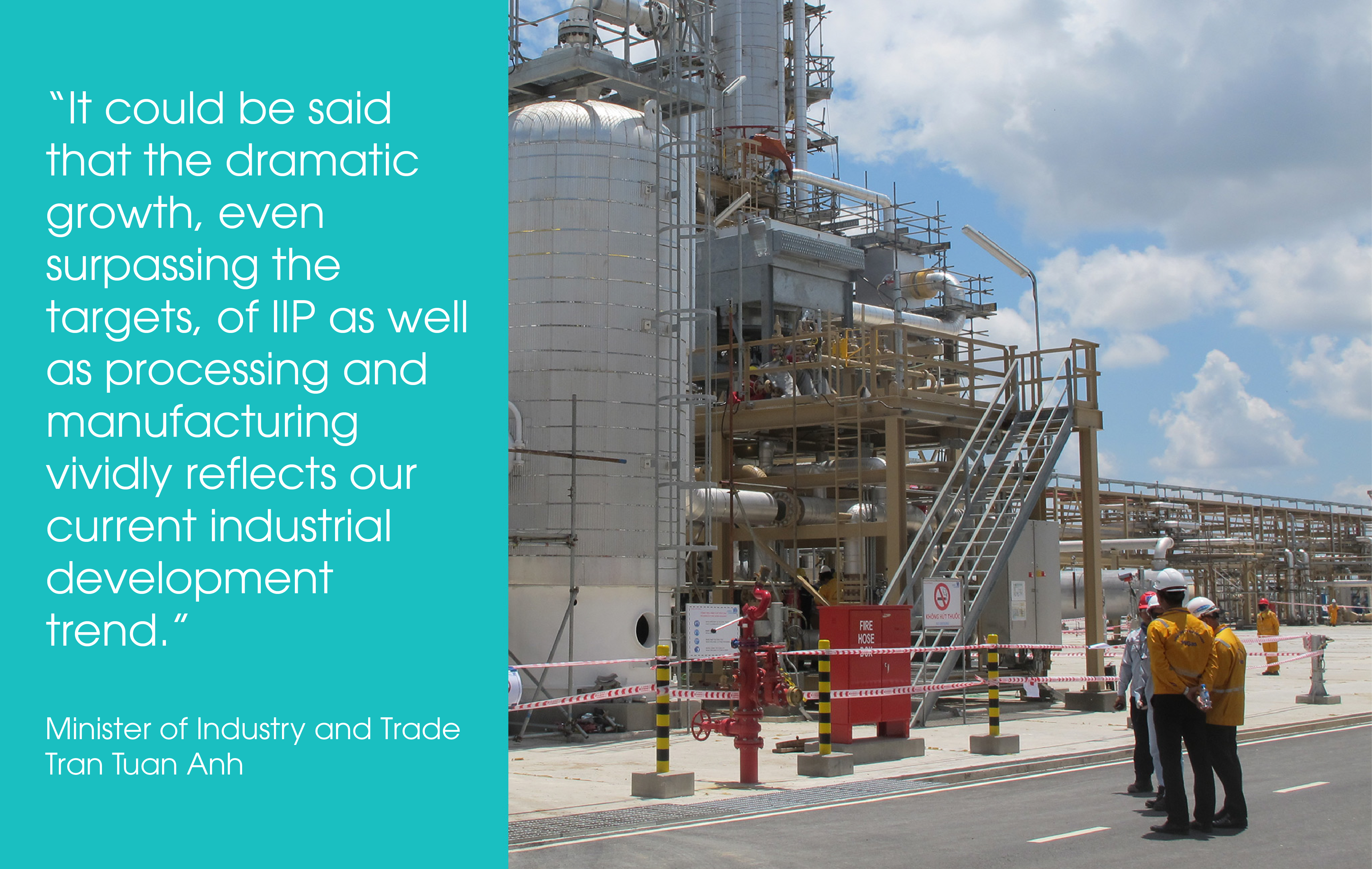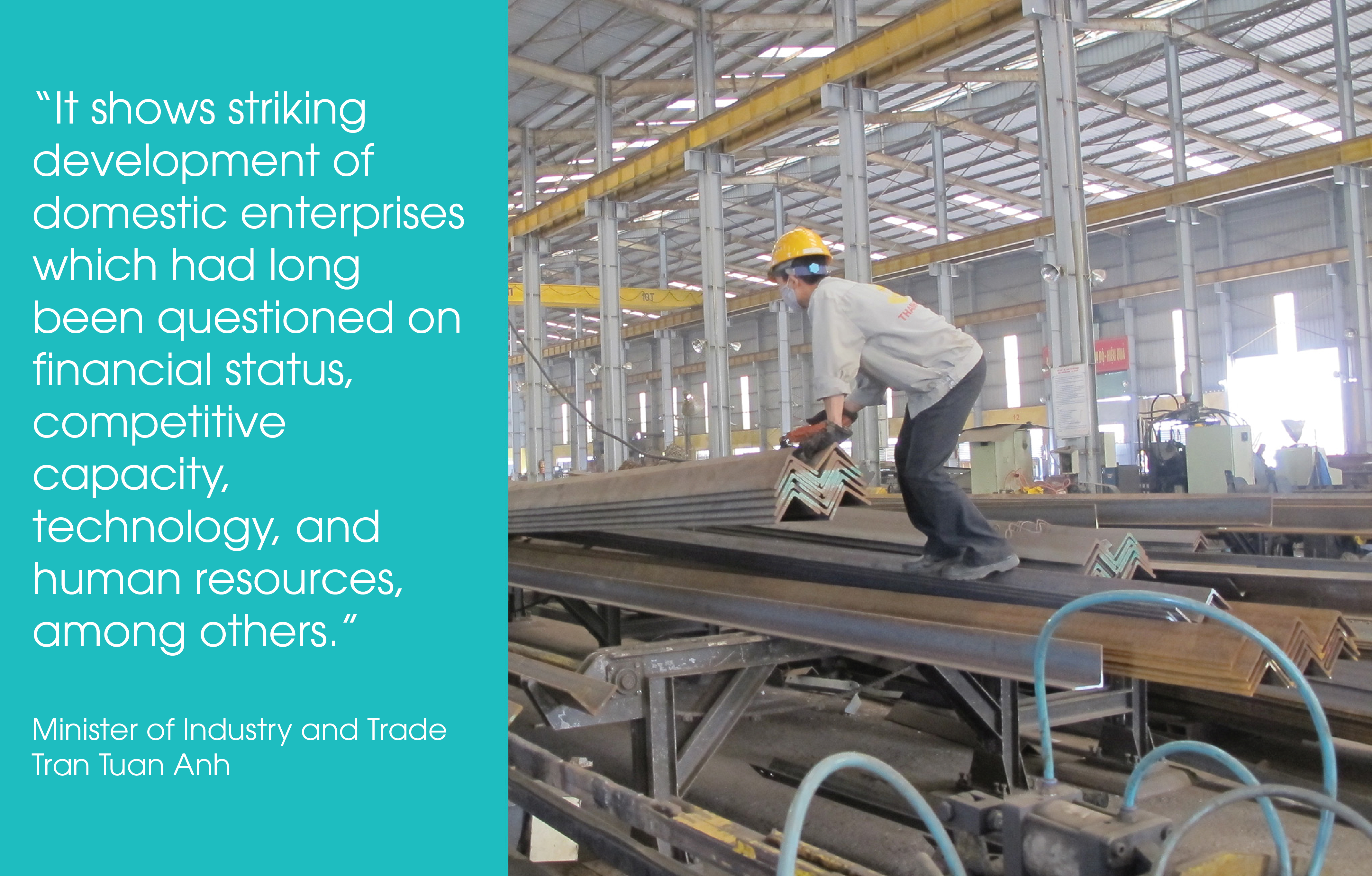2018 was a successful year with industry and trade sector as all set targets were surpassed. Notably, export grew 13.8% or 244.7 billion USD. Export turnover of 29 items exceeding 1 billion USD.
With the aforementioned achievements, Minister of Industry and Trade Tran Tuan Anh said Vietnam has become a big exporter in the world, adding that the export sector has greatly contributed to realizing the target of high economic growth in line with macro-stabilisation and inflation control last year.
In the very first days of 2019, Minister Tran Tuan Anh granted an interview to reporters on the ministry’s concrete steps to fulfill the mission of ‘making breakthroughs’ set by Prime Minister Nguyen Xuan Phuc in his new-year message.
First, could you please share some information regarding national economic growth in 2018?
We have witnessed all-out efforts by the political system as a whole, especially the coherent, comprehensive and aggressive management and direction by the government. The GDP growth of 7.08% last year was a positive signal as it surpassed the economic target set out earlier that year.
The impressive achievement is attributable to drastic guidance by the Government in the very beginning of 2018, especially detailed economic assessments and forecasts, which lay a firm foundation for practical measures and solutions to keep the economic growth on track. Economic outcomes of each quarter are all positive with numerous economic highlights. Therefore, the overall economic growth last year was high with various sectors being kept stable, including export, processing and manufacturing industries, domestic trade, etc. The impressive economic performance of those sectors greatly contributed to the fulfilment of set targets by the government.

We have witnessed all-out efforts by the political system as a whole, especially the coherent, comprehensive and aggressive management and direction by the government.
Particularly, I want to highlight processing and manufacturing, which played their role as momentums for the impressive growth of national index of industrial production (IIP) and GDP.
In 2019, the Government continues to set out GDP growth target of 6.9 to 7% with processing and manufacturing industries and services being the economic driving forces. Could you please share with us the Ministry’s plans to achieve the goal?
It could be said that the dramatic growth, even surpassing the targets, of IIP as well as processing and manufacturing vividly reflects our current industrial development trend.
As I mentioned earlier, the results are largely attributable to the Government’s aggressive guidance in improving business climate and easing bottlenecks in particular sectors and products, especially processing and manufacturing. The positive outcomes of national economy last year also prove effectiveness of the ongoing economic reform, specifically orientations, policies and measures to conduct economic reform.

Besides the impressive growth of processing and manufacturing, lower inventory index also signals improvements of the market, as well as of Vietnamese enterprises’ competitiveness and integration into industrial supply chains.
2018 also marked the third consecutive year Vietnam has enjoyed a trade surplus. Domestic enterprises also actively contributed to export sector in 2018. What do you think about the results and the Ministry’s roles in boosting exports and expanding exporting markets?
In my opinion, the industry and trade sector has exerted great efforts in managing export activities.
In fact, the growth rate of 13.8% in 2018 proves that Vietnam has become a big exporter in the world. Especially given the volatility in a gloomy world trade context with new-style protectionism and unilateralism, Vietnam export value still overwhelmingly exceeded all set targets.
Instead of controlling trade deficit at below 3%, we even reach a trade surplus of 7.2 billion USD.
The same story goes with industry sector as it also met double targets of dramatic growth and trade deficit control. It could be seen that instead of controlling trade deficit at below 3%, we even reach a trade surplus of 7.2 billion USD.
Naming numbers sounds easy but realising it requires all-out efforts by the political system. The numbers proved the effectiveness of our economic reforming and growth model changing through sustainable export strategies, as well as comprehensive and coherent global integration strategies.
Another highlight that worth noticing is Vietnam’s rank in global export map at various goods is high.
For example, besides world’s leading export growth, Vietnam has also affirmed its name in global supply and value chains.
Specifically, Vietnam ranks third worldwide for footwear export and 7th for textile. Other commodities such as rice, coffee and rubber also affirm their position of world leading export values.
But what I mean here is not only Vietnam’s export in general but also individual enterprises in particular. Many firms have become links in global supply chains thanks to their own efforts in improving their capacity and competitive edge.

Notably, domestic enterprises engaging in export activities witnessed an impressive growth of 15.9% in 2018. Meanwhile, foreign direct investment sector, which had always enjoyed trade surplus and high growth in previous years, only saw 13.6% growth in 2018, yet still a remarkable growth rate.
It shows striking development of domestic enterprises which had long been questioned on financial status, competitive capacity, technology, and human resources, among others.
In 2018, 29 sectors and products enjoy export turnover of over one billion USD with five of which gaining over 10 billion USD from export.
I think this was a great momentum for us to enhance capacity of enterprises and expand exporting markets given opportunities brought by multilateral trade system with new-style free trade agreements having been signed and taken effect.
Besides long-term economic reform strategies in industry, agriculture and import-export, the Government has also exerted efforts in management and business environment improvement.
Besides long-term economic reform strategies in industry, agriculture and import-export, the Government has also exerted efforts in management and business environment improvement.
So how does the Ministry deal with domestic trade?
With a market size of nearly 97 million people, Vietnam has also witness the development of various economic sectors. Trade infrastructure system has been improved with more closely-connected and sustainable supply chains.
A huge influx of investment from both foreign and domestic enterprises to develop local retail systems could also be observed.
Given Vietnam has been striving for fulfilling integration commitments, we face both challenges and opportunities. Yet overall, they are all driving forces for economic growth. Integration also results in diversification of consumers’ choices and improvement of distribution channels.

Given Vietnam has been striving for fulfilling integration commitments, we face both challenges and opportunities. Yet overall, they are all driving forces for economic growth.
Could you please share with us some key approaches to fulfill targets set for 2019?
The first target the Ministry of Industry and Trade sets for this year is deploying action programmes in line with the Government’s Resolution on measures to ensure socio-economic development and budget collection in 2019.
Next, the Ministry will stick to targets and objectives approved by the National Assembly, then map out concrete plans and growth prospects for industry, trade and service sectors in every quarter and major periods of time.
We have also paid heed to developing detailed plans for focal products in particular periods of time. Besides long-term solutions, urgent plans should also be devised in response to volatile occurrences in the world.
The first urgent plan is energy supply. It is necessary to set out an oblige target of ensuring sufficient electricity for both economic growth and social demands. The Ministry of Industry and Trade has mapped out four scenarios for this.
Secondly, domestic trade development is the Ministry’s major task, especially given Vietnam’s extensive global integration. Opening domestic market in line with commitments driven from global integration results in more FDI enterprises investing in Vietnam, which expands domestic distribution and retail market. Accordingly, domestic enterprises participating in the distribution market also face fiercer competition. Not to mention, local infrastructure also carries more onerous burden. Given the urgent situation, appropriate legal framework and policies should be devised. Therefore, it is also our focus in this period.
2019 is expected to welcome many favourable conditions while new mechanisms will be improving and proving effective, especially policies aiming at sustainability and stability.
What do you think about growth prospects of sectors under management of the Ministry of Industry and Trade?
In my opinion, with positive and sustainable performance results we have achieved, 2019 is expected to welcome many favourable conditions. New mechanisms will be improving and proving effective, especially policies aiming at sustainability and stability in line with the strategy for sustainable import-export and strategy for economic reforming and growth model transforming.
We have mapped out detail guidelines in concrete plans for each year and specific periods of time. Moreover, we have a lot of experiences being drawn from our journey of global integration, from which we have taken more cautious and confident steps. I do believe that those experiences will help a lot in the Government’s policy making and management in 2019, especially given more new-generation FTAs coming into force, creating a growth momentum for the economy.
I think the socio-economic growth in general and for sectors under the Ministry’s management in particular will achieve fruitful outcomes in 2019.
Thank you Minister!

